The Effect of Smoking on the Number and Type of Rectal Aberrant Crypt Foci (ACF)—First Identifiable Precursors of Colorectal Cancer (CRC)
Abstract
1. Introduction
2. Methods
3. Results
4. Discussion
5. Conclusions
Author Contributions
Funding
Conflicts of Interest
Abbreviations
| ACF | aberrant crypt foci |
| CRC | colorectal cancer |
| k-ras | Kirsten rat sarcoma viral oncogene homolog |
| BRAF mutation | type B rapid accelerated fibrosarcoma |
| MSI | Microsatellite instability |
| CIMP | CpG island methylator phenotype |
| MMR | Mismatch repair |
| COX-2 | Cyclooxygenase-2 |
| TXA2 | Thromboxane A2 |
| PGE2 | Prostaglandin E2 |
References
- Anderson, J.C.; Attam, R.; Alpern, Z.; Messina, C.R.; Hubbard, P.; Grimson, R.; Ells, P.F.; Brand, D.L. Prevalence of colorectal neoplasia in smokers. Am. J. Gastroenterol. 2003, 98, 2777–2783. [Google Scholar] [CrossRef]
- Kowalczyk, M.; Siermontowski, P.; Mucha, D.; Ambroży, T.; Orłowski, M.; Zinkiewicz, K.; Kurpiewski, W.; Paśnik, K.; Kowalczyk, I.; Pedrycz, A. Chromoendoscopy with a standard- resolution colonoscope for evaluation of rectal Aberrant Crypt Foci. PLoS ONE 2016, 11, e0148286. [Google Scholar] [CrossRef] [PubMed]
- Kowalczyk, M.; Orłowski, M.; Siermontowski, P.; Mucha, D.; Zinkiewicz, K.; Kurpiewski, W.; Zieliński, E.; Kowalczyk, I.; Pedrycz, A. Occurrence of colorectal aberrant crypt foci depending on age and dietary patterns of patients. BMC Cancer 2018, 18, 213. [Google Scholar] [CrossRef] [PubMed]
- Samowitz, W.S.; Albertsen, H.; Sweeney, C. Association of smoking, CpG island methylator phenotype, and BRAF mutations in colon cancer. J. Natl. Cancer Inst. 2006, 98, 1731–1738. [Google Scholar] [CrossRef] [PubMed]
- Anderson, J.C.; Pleau, D.C.; Rajan, T.V. Increased Frequency of serrated aberrant crypt foci among smokers. Am. J. Gastroenterol. 2010, 105, 1648–1654. [Google Scholar] [CrossRef]
- Jass, J.R. Hyperplastic polyps and colorectal cancer: Is there a link? Clin. Gastroenterol. Hepaatol. 2004, 2, 1–8. [Google Scholar] [CrossRef]
- Jass, J.R. Classification of colorectal cancer based on correlation of clinical, morphological and molecular features. Histopatology 2007, 50, 113–130. [Google Scholar] [CrossRef]
- Roncucci, L.; Stamp, D.; Medline, A.; Cullen, J.B.; Bruce, W.R. Identification and quantification of aberrant crypt foci and microadenomas in the human colon. Hum. Pathol. 1991, 22, 287–294. [Google Scholar] [CrossRef]
- Moxon, D.; Raza, M.; Kenney, R.; Ewing, R.; Arozullah, A.; Mason, J.B.; Carroll, R.E. Aging and tobacco use are linked to the development of aberrant crypt foci (ACF) in a predominantly African-American population. Clin. Gastroenterol. Hepatol. 2005, 3, 271–278. [Google Scholar] [CrossRef]
- Ng, M.; Freeman, M.K.; Fleming, T.D.; Robinson, M.; Dwyer-Lindgren, L.; Thomson, B.; Wollum, A.; Sanman, E.; Wulf, S.; Lopez, A.D.; et al. Smoking Prevalence and Cigarette Consumption in 187 Countries, 1980–2012. JAMA 2014, 311, 183–192. [Google Scholar] [CrossRef]
- Mutch, M.G.; Schoen, R.G.; Fleshman, J.W. A Multicenter Study of Prevalence and Risk Factors for Aberrant Crypt Foci. Clin. Gastroenterol. Hepatol. 2009, 7, 568–574. [Google Scholar] [CrossRef] [PubMed]
- Orlando, F.A.; Tan, D.; Baltodano, J.D.; Khoury, T.; Gibbs, J.F.; Hassid, V.J.; Ahmed, B.H.; Alrawi, S.J. Aberrant Crypt Foci as Precursors in Colorectal Cancer Progression. J. Surg. Oncol. 2008, 98, 207–213. [Google Scholar] [CrossRef] [PubMed]
- Rudolph, R.E.; Dominitz, J.A.; Lampe, J.W.; Levy, L.; Qu, P.; Li, S.S.; Bronner, M.P.; Potter, J.D. Risk Factors for Colorectal Cancer in Relation to Number and Size of Aberrant Crypt Foci in Humans. Cancer Epidemiol. Biomark. Prev. 2005, 14, 605–608. [Google Scholar] [CrossRef] [PubMed]
- Limsui, D.; Vierkant, R.A.; Tillmans, L.S.; Wang, A.H.; Weisenberger, D.J.; Laird, P.W.; Lynch, C.F.; Anderson, K.E.; French, A.J.; Haile, R.W.; et al. Cigarette Smoking and Colorectal Cancer Risk by Molecularly Defined Subtypes. J. Natl. Cancer Inst. 2010, 102, 1012–1022. [Google Scholar] [CrossRef] [PubMed]
- Lee, K.W.; Pausova, Z. Cigarette smoking and DNA methylation. Front Genet. 2013, 4, 132. [Google Scholar] [CrossRef] [PubMed]
- Qiu, W.; Wan, E.; Morrow, J.; Cho, M.H.; Crapo, J.D.; Silverman, E.K.; DeMeo, D.L. The impact of genetic variation and cigarette smoke on DNA methylation in current and former smokers from the COPDGene study. Epigenetics 2015, 10, 1064–1073. [Google Scholar] [CrossRef]
- Kuźmińska, P.; Karakiewicz, B.; Rotter, I. Wpływ palenia tytoniu na wybrane składniki mineralne: Wapń, magnez, żelazo, cynk i selen—Przegląd badań. Medycyna Ogólna Nauki Zdrowiu 2012, 18, 409–415. [Google Scholar]
- Kanno, T.; Nakamura, K.; Ikai, H.; Kikuchi, K.; Sasaki, K.; Niwano, Y. Literature review of the role of hydroxyl radicals in chemically-induced mutagenicity and carcinogenicity for the risk assessment of a disinfection system utilizing photolysis of hydrogen peroxide. J. Clin. Biochem. Nutr. 2012, 51, 9–14. [Google Scholar] [CrossRef][Green Version]
- Reid, M.E.; Marshall, J.R.; Roe, D.; Lebowitz, M.; Alberts, D.; Battacharyya, A.K.; Martinez, M.E. Smoking Exposure as a Risk Factor for Prevalent and Recurrent Colorectal Adenomas. Cancer Epidemiol. Biomark. Prev. 2003, 12, 1006–1011. [Google Scholar]
- Trock, B.; Lanza, E.; Greenwald, P. Dietary fiber, vegetables and colon cancer: Critical revive and meta-analyses of the epidemiological evidence. J. Natl. Cancer Inst. 1990, 82, 650–661. [Google Scholar] [CrossRef]
- Howe, G.R.; Benito, E.; Castelleto, R.; Cornée, J.; Estève, J.; Gallagher, R.P.; Iscovich, J.M.; Deng-ao, J.; Kaaks, R.; Kune, G.A.; et al. Dietary intake of fiber and decreased risk of cancer of colon and rectum:evidence from the combined analysis of 13 case-control studies. J. Natl. Cancer Inst. 1992, 84, 1887–1896. [Google Scholar] [CrossRef] [PubMed]
- Willett, W.C. Diet and Cancer. Oncologist 2000, 5, 393–404. [Google Scholar] [CrossRef] [PubMed]
- de KOK, T.M.; van Fassen, A.; Glinghammar, B.; Pachen, D.M.F.A.; Rafter, J.J.; Baeten, C.G.M.I.; Engels, L.G.J.B.; Kleinjans, J.C.S. Bile acid concentrations, cytotoxicity, and pH of fecal water from patients with colorectal adenomas. Dig. Dis. Sci. 2000, 44, 2218–2225. [Google Scholar] [CrossRef] [PubMed]
- Hong, B.; Ideta, T.; Igarashi, Y.; Tan, Y.; DiSiena, M.; Mo, A.; Birk, J.W.; Forouhar, F.; Devers, T.J.; Weinstock, G.M.; et al. Characterization of Mucosal Dysbiosis of Early Colonic Neoplasia. npj Precis. Onc. 2019, 3, 29. [Google Scholar] [CrossRef] [PubMed]
- Toyomura, K.; Yamaguchi, K.; Kawamoto, H.; Tabata, S.; Shimizu, E.; Mineshita, M.; Ogawa, S.; Lee, K.-Y.; Kono, S. Relation of cigarette smoking and alcohol use to colorectal adenomas by subsite: The self-defense forces health study. Cancer Sci. 2004, 95, 72–76. [Google Scholar] [CrossRef] [PubMed]
- Botteri, E.; Iodice, S.; Bagnardi, V.; Raimondi, S.; Lowenfels, A.B.; Maisonneuve, P. Smoking and Colorectal Cancer: A meta-analysis. JAMA 2008, 300, 2765–2778. [Google Scholar] [CrossRef] [PubMed]
- Takayama, T.; Katsuki, S.; Takahashi, Y.; Ohi, M.; Nojiri, S.; Sakamaki, S.; Kato, J.; Kogawa, K.; Miyake, H.; Niitsu, Y. Aberrant Crypt Foci of the Colon as Precursors of Adenoma and Cancer. N. Engl. J. Med. 1998, 339, 1277–1284. [Google Scholar] [CrossRef]
- Figueiredo, J.C.; Crockett, S.D.; Snover, D.C.; Morris, C.B.; Mckeown-Eyssen, G.; Sandler, R.S.; Ahnen, D.J.; Robertson, U.J.; Burke, C.A.; Bresalier, R.S.; et al. Smoking-associated risks of conventional adenomas and serrated polyps in the colorectum. Cancer Causes Control 2015, 26, 377–386. [Google Scholar] [CrossRef]
- Shrubsole, M.J.; Wu, H.; Ness, R.M.; Shyr, Y.; Smalley, W.E.; Zheng, W. Alcohol Drinking, Cigarette Smoking, and Risk of Colorectal Adenomatous and Hyperplastic Polyps. Am. J. Epidemiol. 2008, 167, 1050–1058. [Google Scholar] [CrossRef]
- Paskett, E.D.; Reeves, K.W.; Pineau, B.; Albert, P.S.; Caan, B.; Hasson, M.; Iber, F.; Kikendall, J.W.; Lance, P.; Shike, M.; et al. The Association between Cigarette Smoking and Colorectal Polyp Recurrence (United States). Cancer Causes Control 2005, 16, 1021–1033. [Google Scholar] [CrossRef]
- Morimoto, L.M.; Newcomb, P.A.; Ulrich, C.M.; Bostick, R.M.; Lais, C.J.; Potter, J.D. Risk factors for hyperplastic and adenomatous polyps: Evidence for malignant potential? Cancer Epidemiol. Biomark. Prev. 2002, 10 Pt 1, 1012–1018. [Google Scholar]
- Nosho, K.; Irahara, N.; Shima, K.; Kure, S.; Kirkner, G.J.; Schernhammer, E.S.; Hazra, A.; Hunter, D.J.; Quackenbush, J.; Spiegelman, D.; et al. Comprehensive Biostatistical Analysis of CpG Island Methylator Phenotype in Colorectal Cancer Using a Large Population-Based Sample. PLoS ONE 2008, 3, e3698. [Google Scholar] [CrossRef] [PubMed]
- Roncucci, L.; Modica, S.; Pedroni, M.; Tamassia, M.G.; Ghidoni, M.; Losi, L.; Fante, R.; Di Gregorio, C.; Manenti, A.; Gafa, L.; et al. Aberrant crypt foci in patients with colorectal cancer. Br. J. Cancer 1998, 77, 2343–2348. [Google Scholar] [CrossRef] [PubMed]
- Burnett-Hartman, A.N.; Newcomb, P.A.; Mandelson, M.T.; Adams, S.V.; Wernli, K.J.; Shadman, M.; Wurscher, M.A.; Makar, K.W. Colorectal Polyp Type and the Association With Charred Meat Consumption, Smoking, and Microsomal Epoxide Hydrolase Polymorphisms. Nutr. Cancer 2011, 63, 583–592. [Google Scholar] [CrossRef]
- Liang, P.S.; Chen, T.-Y.; Giovannucci, E. Cigarette smoking and colorectal cancer incidence and mortality: Systematic review and meta-analysis. Int. J. Cancer 2009, 124, 2406–2415. [Google Scholar] [CrossRef]
- Poynter, J.N.; Haile, R.W.; Siegmund, K.D.; Campbell, P.T.; Figueiredo, J.C.; Limburg, P.; Young, J.P.; Le Marchand, L.; Potter, J.D.; Cotterchio, M.; et al. Associations between Smoking, Alcohol Consumption, and Colorectal Cancer, Overall and by Tumor Microsatellite Instability Status. Cancer Epidemiol. Biomark. Prev. 2009, 18, 2745–2750. [Google Scholar] [CrossRef]
- Stintzing, S.; Tejpar, S.; Gibbs, P.; Thiebach, L.; Lenz, H.-J. Understanding the role of primary tumour localisation in colorectal cancer treatment and outcomes. Eur. J. Cancer 2017, 84, 69–80. [Google Scholar] [CrossRef]
- Gervaz, P.; Bucher, P.; Morel, P.J. Two colons-two cancers: Paradigm shift and clinical implications. Surg. Oncol. 2004, 88, 261–266. [Google Scholar] [CrossRef]
- Lüchtenborg, M.; White, K.K.; Wilkens, L.; Kolonel, L.N.; Le Marchand, L. Smoking and Colorectal Cancer: Different Effects by Type of Cigarettes? Cancer Epidemiol. Biomark. Prev. 2007, 16, 1341–1347. [Google Scholar] [CrossRef][Green Version]
- Jalving, M.; Koornstra, J.J.; De Jong, S.; de Vries, E.G.E.; Kleibeuker, J.H. The potential of combinational regimen with non-steroidal anti-inflammatory drugs in the chemoprevention of colorectal cancer. Aliment. Pharmacol. Ther. 2005, 21, 321–339. [Google Scholar] [CrossRef]
- Shiff, S.J.; Rigas, B. Nonsteroidal anti-inflammatory drugs and colorectal cancer: Evolving concepts of their chemopreventive actions. Gastroenterology 1997, 113, 1992–1998. [Google Scholar] [CrossRef]
- Figueiredo, P.; Donato, M.M. Cyclooxygenase-2 is overexpressed in aberrant crypt foci of smokers. Eur. J. Gastroenterol. Hepatol. 2010, 22, 1271. [Google Scholar] [CrossRef] [PubMed]
- Hecht, S.S. Tobacco carcinogens, their biomarkers and tobacco-induced cancer. Nat. Rev. Cancer 2003, 3, 733–744. [Google Scholar] [CrossRef] [PubMed]
- Giovannucci, E. An updated review of the epidemiological evidence that cigarette smoking increases risk of colorectal cancer. Cancer Epidemiol. Biomark. Prev. 2001, 10, 725–731. [Google Scholar]
- Kowalczyk, M.; Orłowski, M.; Klepacki, Ł.; Zinkiewicz, K.; Kurpiewski, W.; Kaczerska, D.; Pesta, W.; Zieliński, E.; Siermontowski, P. Rectal aberrant crypt foci (ACF) as a predictor of benign and malignant neoplastic lesions in the large intestine. BMC Cancer 2020, 20, 133. [Google Scholar] [CrossRef]
- Siu, I.M.; Pretlow, T.G.; Amini, S.B.; Pretlow, T.P. Identification of dysplasia in human colonic aberrant crypt foci. Am. J. Pathol. 1997, 150, 1805–1813. [Google Scholar]
- Otori, K.; Sugiyama, K.; Hasebe, T.; Fukushima, S.; Esumi, H. Emergence of adenomatous aberrant crypt foci (ACF) from hyperplastic ACF with concomitant increase in cell proliferation. Cancer Res. 1995, 55, 4743–4746. [Google Scholar]
- Orłowska, J.; Kiedrowski, M. Serrated adenomas, hyperplastic polyposis and carcinoma of the colorectum. Borgis Postępy Nauk Medycznych 2009, 2, 111–117. [Google Scholar]
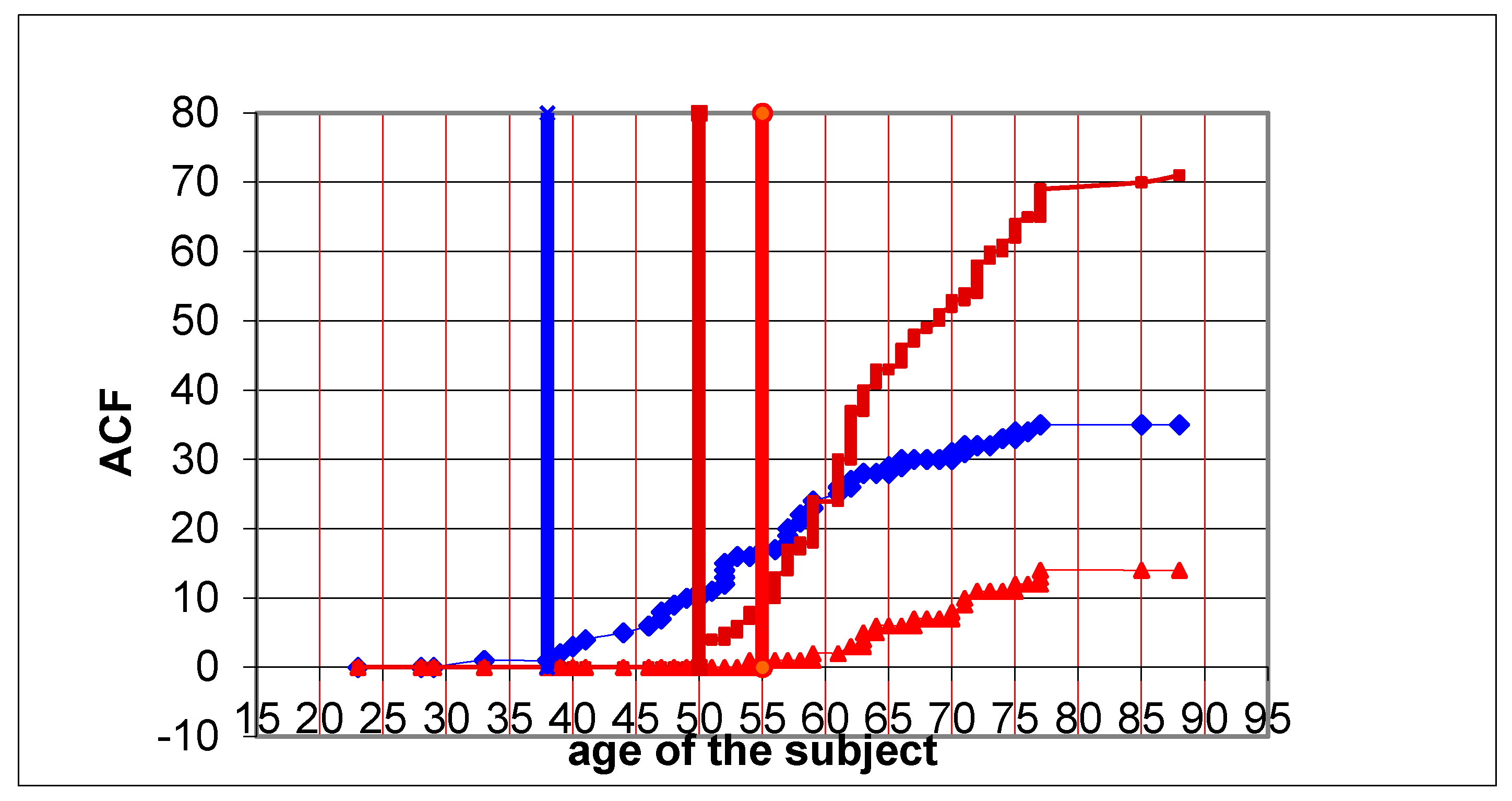
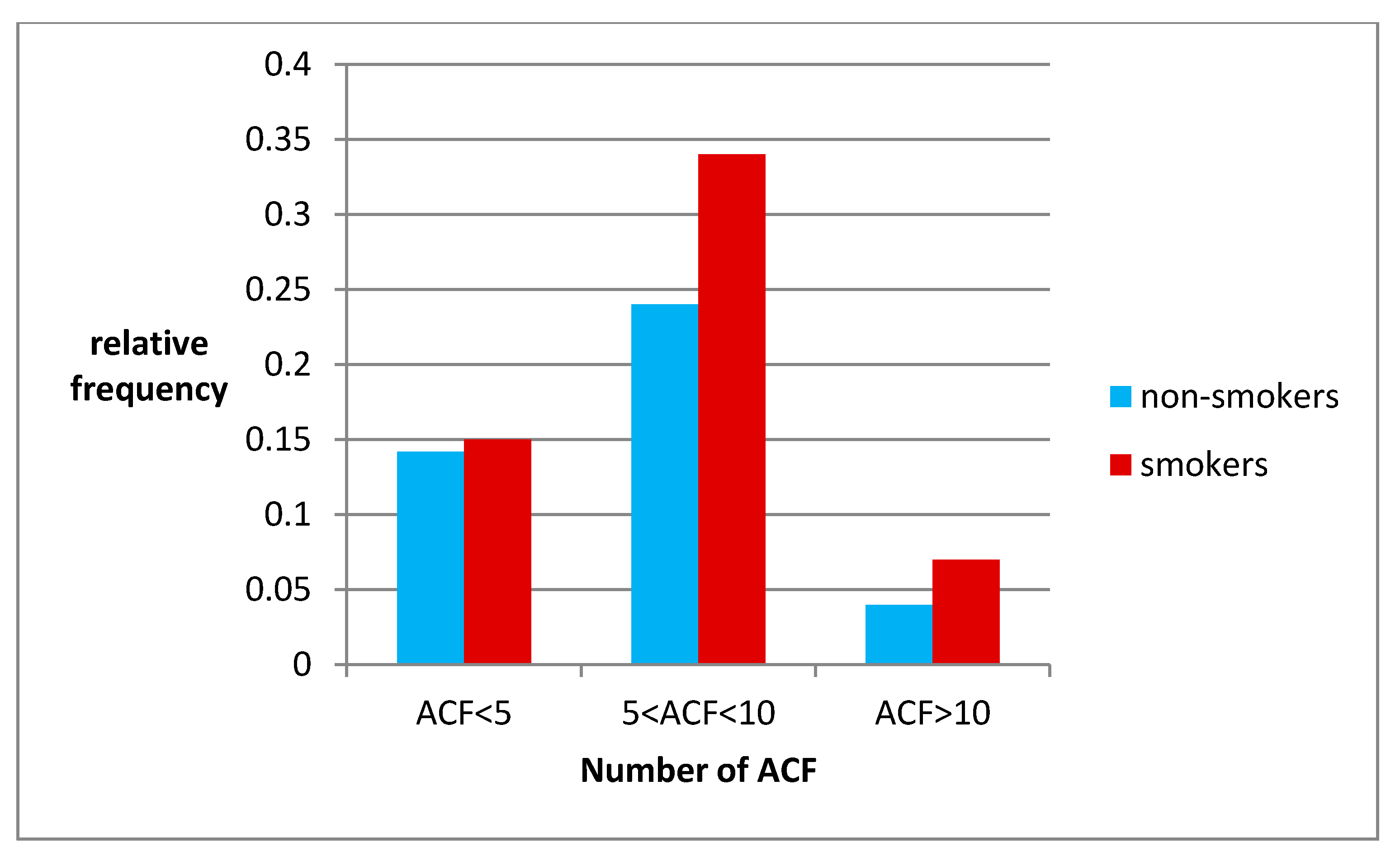
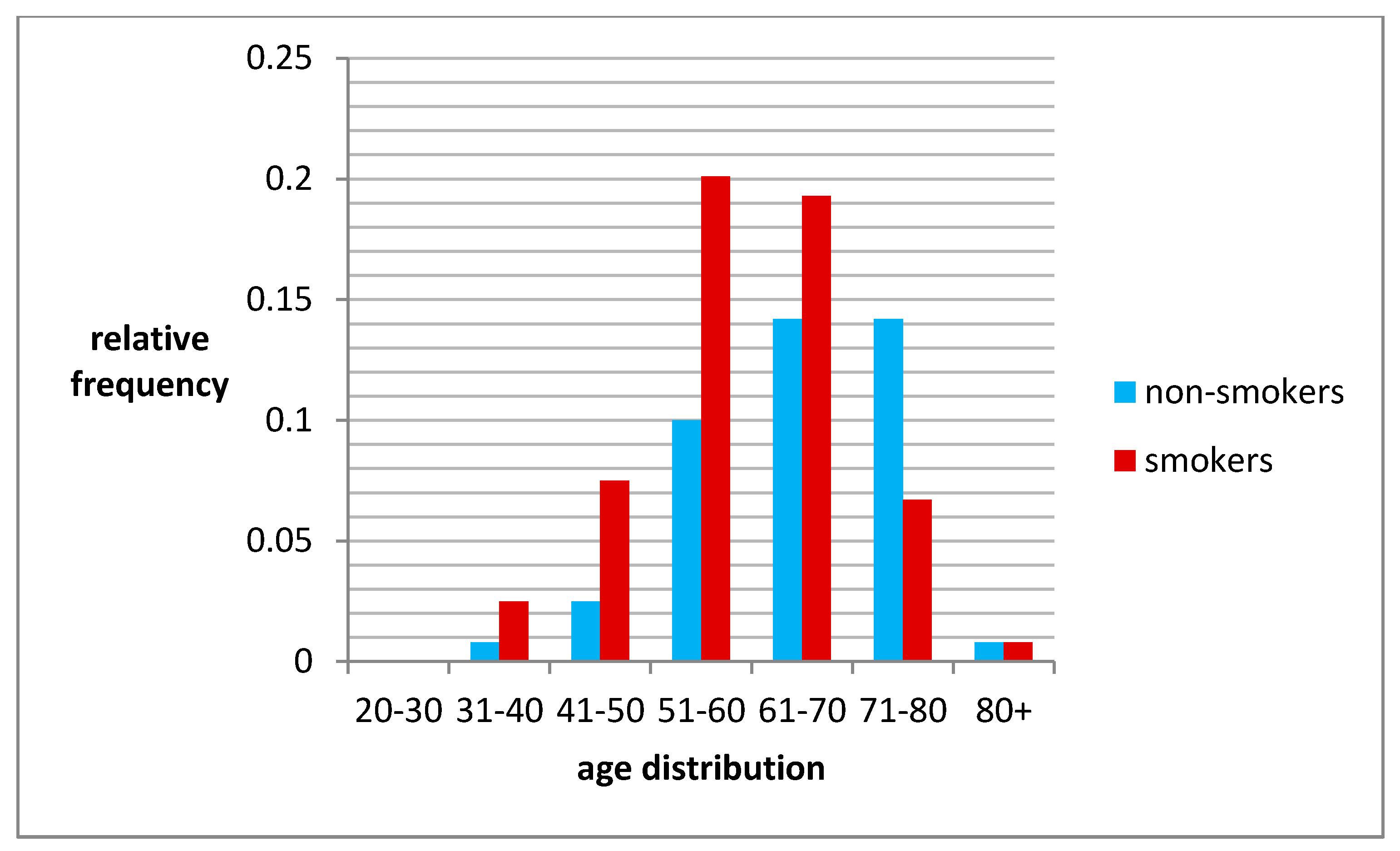
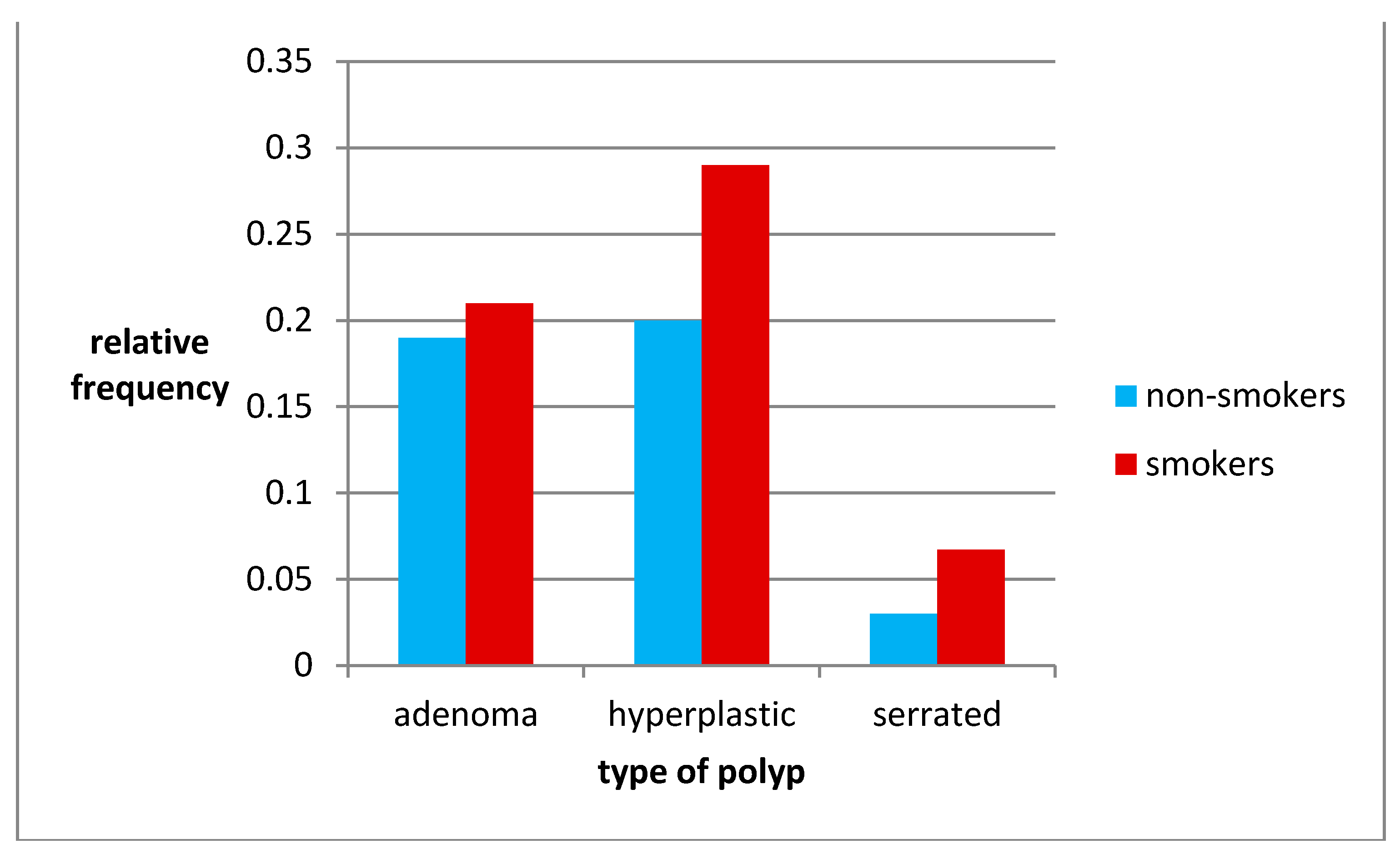
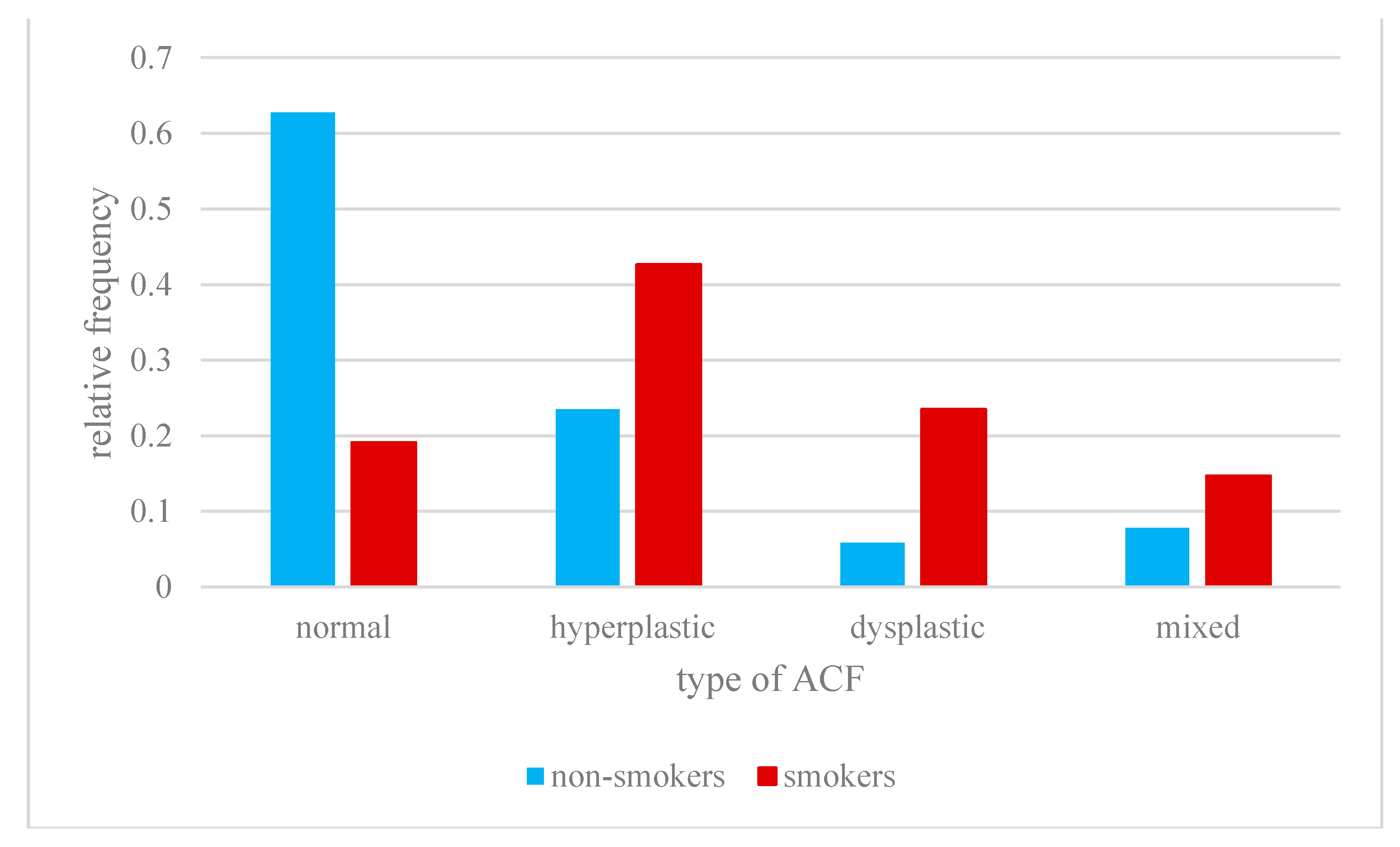
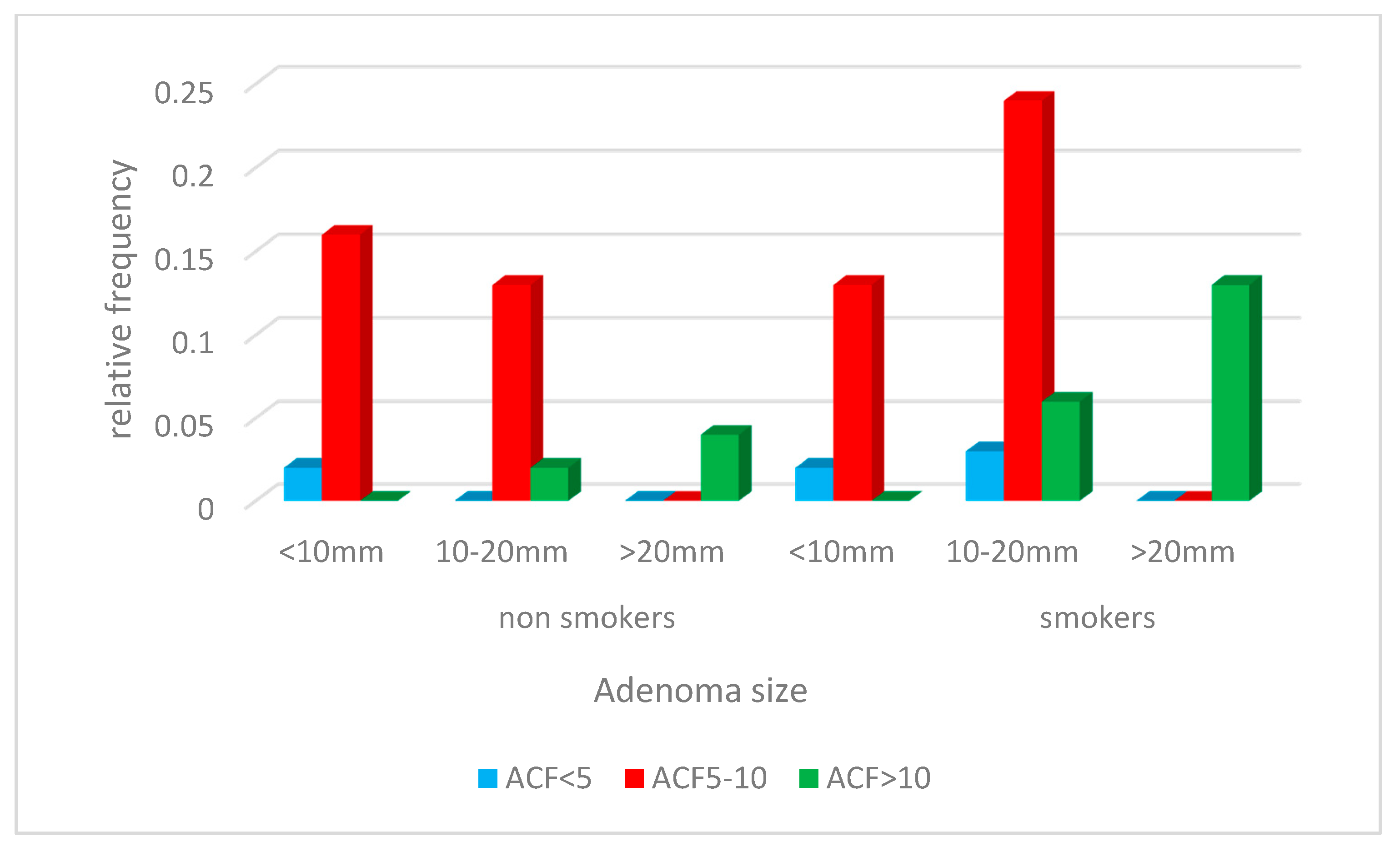
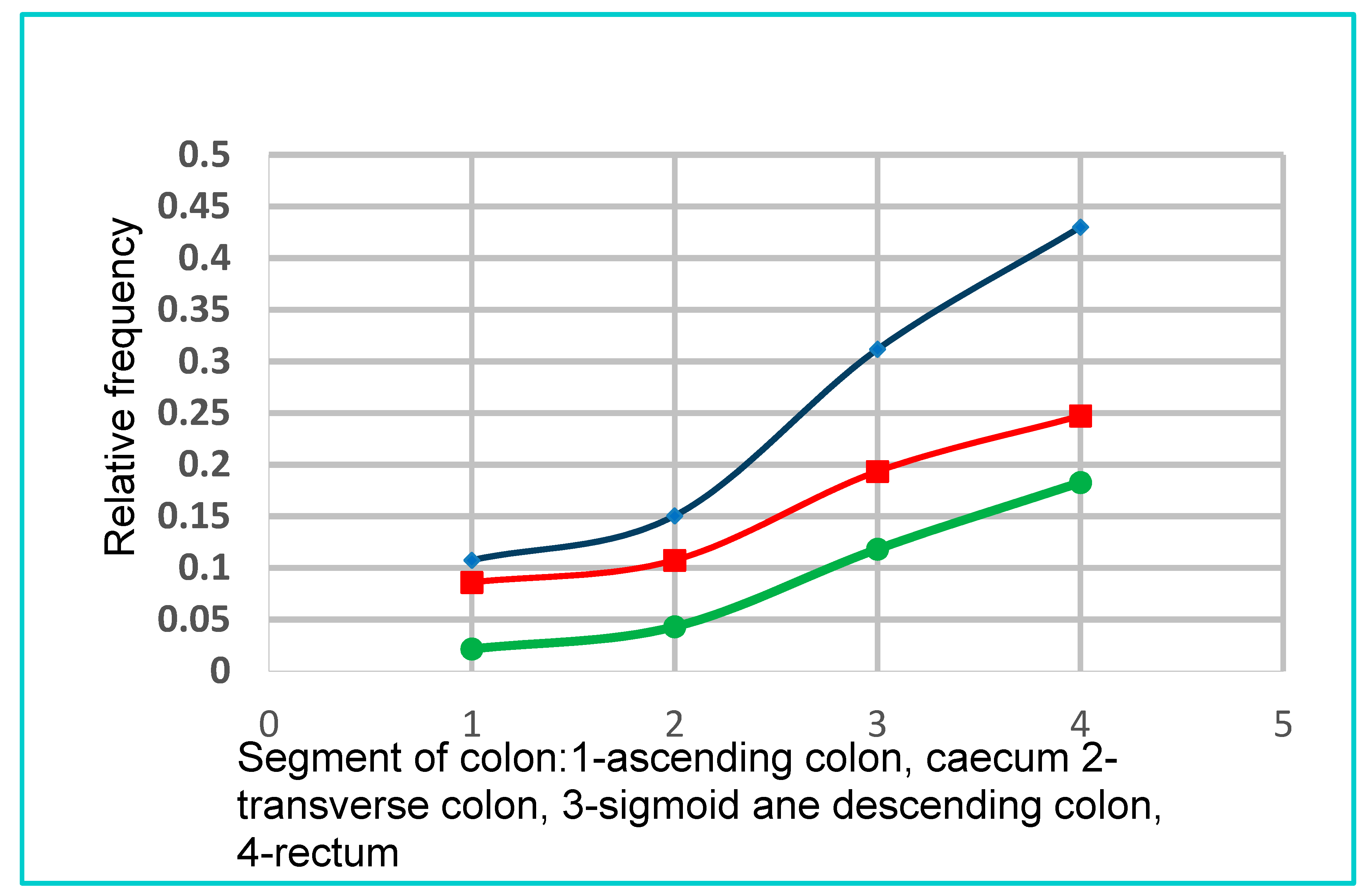
| Non-Smokers | Smokers | ||
|---|---|---|---|
| Number of ACF | <5 | 17 | 18 |
| 5–10 | 29 | 41 | |
| >10 | 5 | 9 | |
| Type of ACF | Normal | 32 | 13 |
| Hyperplastic | 12 | 29 | |
| Dysplastic | 3 | 16 | |
| Mixed | 4 | 10 | |
| Type of polyp | Adenoma | 14 | 25 |
| Hyperplastic | 19 | 30 | |
| Serrated | 4 | 8 | |
| Adenoma (size) | <10 mm | 1 | 2 |
| 10–20 mm | 14 | 19 | |
| >20 mm | 3 | 9 | |
| Age groups of subjects (years old) | <30 | 0 | 0 |
| 31–40 | 3 | 1 | |
| 41–50 | 9 | 3 | |
| 51–60 | 24 | 12 | |
| 61–70 | 23 | 17 | |
| 71–80 | 8 | 17 | |
| >80 | 1 | 1 | |
| location of polyps in different sections of the large intestine | rectum | 14 | 16 |
| sigmoid and descending colon | 8 | 123 | |
| transverse colon | 6 | 12 | |
| ascending colon, caecum | 3 | 9 | |
Publisher’s Note: MDPI stays neutral with regard to jurisdictional claims in published maps and institutional affiliations. |
© 2020 by the authors. Licensee MDPI, Basel, Switzerland. This article is an open access article distributed under the terms and conditions of the Creative Commons Attribution (CC BY) license (http://creativecommons.org/licenses/by/4.0/).
Share and Cite
Kowalczyk, M.; Klepacki, Ł.; Zieliński, E.; Kurpiewski, W.; Zinkiewicz, K.; Dyśko, Ł.; Pesta, W. The Effect of Smoking on the Number and Type of Rectal Aberrant Crypt Foci (ACF)—First Identifiable Precursors of Colorectal Cancer (CRC). J. Clin. Med. 2021, 10, 55. https://doi.org/10.3390/jcm10010055
Kowalczyk M, Klepacki Ł, Zieliński E, Kurpiewski W, Zinkiewicz K, Dyśko Ł, Pesta W. The Effect of Smoking on the Number and Type of Rectal Aberrant Crypt Foci (ACF)—First Identifiable Precursors of Colorectal Cancer (CRC). Journal of Clinical Medicine. 2021; 10(1):55. https://doi.org/10.3390/jcm10010055
Chicago/Turabian StyleKowalczyk, Marek, Łukasz Klepacki, Ewa Zieliński, Waldemar Kurpiewski, Krzysztof Zinkiewicz, Łukasz Dyśko, and Wiesław Pesta. 2021. "The Effect of Smoking on the Number and Type of Rectal Aberrant Crypt Foci (ACF)—First Identifiable Precursors of Colorectal Cancer (CRC)" Journal of Clinical Medicine 10, no. 1: 55. https://doi.org/10.3390/jcm10010055
APA StyleKowalczyk, M., Klepacki, Ł., Zieliński, E., Kurpiewski, W., Zinkiewicz, K., Dyśko, Ł., & Pesta, W. (2021). The Effect of Smoking on the Number and Type of Rectal Aberrant Crypt Foci (ACF)—First Identifiable Precursors of Colorectal Cancer (CRC). Journal of Clinical Medicine, 10(1), 55. https://doi.org/10.3390/jcm10010055





